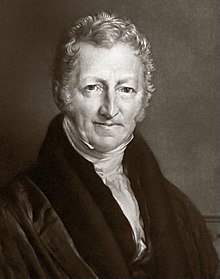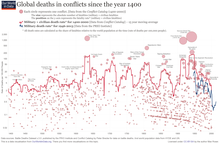A Malthusian catastrophe (also known as Malthusian trap, population trap, Malthusian check, Malthusian crisis, Malthusian spectre, Malthusian crunch) occurs when population growth outpaces agricultural production, causing population to be limited by famine or war. It is named after Thomas Robert Malthus, who suggested that while technological advances could increase a society's supply of resources, such as food, and thereby improve the standard of living, the resource abundance would enable population growth, which would eventually bring the per capita supply of resources back to its original level. Some economists contend that since the industrial revolution, mankind has broken out of the trap. Others argue that the continuation of extreme poverty indicates that the Malthusian trap continues to operate. Others further argue that due to lack of food availability coupled with excessive pollution, developing countries show more evidence of the trap.
Malthus' theoretical argument
In 1798, Thomas Malthus proposed his theory in An Essay on the Principle of Population.
He argued that society has a natural propensity to increase its population, a propensity that causes population growth to be the best measure of the happiness of a people: "The happiness of a country does not depend, absolutely, upon its poverty, or its riches, upon its youth, or its age, upon its being thinly, or fully inhabited, but upon the rapidity with which it is increasing, upon the degree in which the yearly increase of food approaches to the yearly increase of an unrestricted population."
However, the propensity for population increase also leads to a natural cycle of abundance and shortages:
We will suppose the means of subsistence in any country just equal to the easy support of its inhabitants. The constant effort towards population...increases the number of people before the means of subsistence are increased. The food therefore which before supported seven millions, must now be divided among seven millions and a half or eight millions. The poor consequently must live much worse, and many of them be reduced to severe distress. The number of labourers also being above the proportion of the work in the market, the price of labour must tend toward a decrease; while the price of provisions would at the same time tend to rise. The labourer therefore must work harder to earn the same as he did before. During this season of distress, the discouragements to marriage, and the difficulty of rearing a family are so great, that population is at a stand. In the mean time the cheapness of labour, the plenty of labourers, and the necessity of an increased industry amongst them, encourage cultivators to employ more labour upon their land; to turn up fresh soil, and to manure and improve more completely what is already in tillage; till ultimately the means of subsistence become in the same proportion to the population as at the period from which we set out. The situation of the labourer being then again tolerably comfortable, the restraints to population are in some degree loosened; and the same retrograde and progressive movements with respect to happiness are repeated.
— Thomas Malthus, 1798. An Essay on the Principle of Population, Chapter II.
Famine seems to be the last, the most dreadful resource of nature. The power of population is so superior to the power of the earth to produce subsistence for man, that premature death must in some shape or other visit the human race. The vices of mankind are active and able ministers of depopulation. They are the precursors in the great army of destruction, and often finish the dreadful work themselves. But should they fail in this war of extermination, sickly seasons, epidemics, pestilence, and plague advance in terrific array, and sweep off their thousands and tens of thousands. Should success be still incomplete, gigantic inevitable famine stalks in the rear, and with one mighty blow levels the population with the food of the world.
— Thomas Malthus, 1798. An Essay on the Principle of Population. Chapter VII, p. 61
Malthus faced opposition from economists both during his life and since. A vocal critic several decades later was Friedrich Engels.
Modern formulation
The modern formulation of the Malthusian theory was developed by Qumarul Ashraf and Oded Galor. Their theoretical structure suggests that as long as: (i) higher income has a positive effect on reproductive success, and (ii) land is limited factor of production, then technological progress has only a temporary effect in income per capita. While in the short-run technological progress increases income per capita, resource abundance created by technological progress would enable population growth, and would eventually bring the per capita income back to its original long-run level.
The testable prediction of the theory is that during the Malthusian epoch technologically advanced economies were characterized by higher population density, but their level of income per capita was not different than the level in societies that are technologically backward.
Preventive vs. positive population controls
Malthus proposed two kinds of population checks: preventive and positive.
A preventive check is a conscious decision to delay marriage or abstain from procreation based on a lack of resources. Malthus argued that man is incapable of ignoring the consequences of uncontrolled population growth, and would intentionally avoid contributing to it. According to Malthus, a positive check is any event or circumstance that shortens the human life span. The primary examples of this are war, plague and famine. However, poor health and economic conditions are also considered instances of positive checks.
Neo-Malthusian theory
The rapid increase in the global population since 1900 exemplifies Malthus's predicted population patterns, whereby expansion of food supply has encouraged population growth. "Neo-Malthusianism" may be used as a label for those who are concerned that human overpopulation may increase resource depletion or environmental degradation to a degree that is not sustainable. Many in environmental movements express concern over the potential dangers of population growth. In 1968, ecologist Garrett Hardin published an influential essay in Science that drew heavily from Malthusian theory. His essay, "The Tragedy of the Commons," argued that "a finite world can support only a finite population" and that "freedom to breed will bring ruin to all." The Club of Rome published a famous book entitled The Limits to Growth in 1972. Paul R. Ehrlich is a prominent neo-Malthusian who first raised concerns in 1968 with the publication of The Population Bomb.
A study conducted in 2009 said that food production will have to increase by 70% over the next 40 years, and food production in the developing world will need to double. This is a result of the increasing population (world population will increase to 9.1 billion in 2050, where there are just 7.8 billion people today). The effects of global warming (floods, droughts, extreme weather events, ...) are expected to negatively affect food production, with different impacts in different regions. As a result, we will need to use the scarce natural resources more efficiently and adapt to climate change. The use of agricultural resources for biofuels may also put downward pressure on food availability.
Evidence in support
Research indicates that technological superiority and higher land productivity had significant positive effects on population density but insignificant effects on the standard of living during the time period 1–1500 AD. In addition, scholars have reported on the lack of a significant trend of wages in various places over the world for very long stretches of time. In Babylonia during the period 1800 to 1600 BC, for example, the daily wage for a common laborer was enough to buy about 15 pounds of wheat. In Classical Athens in about 328 BC, the corresponding wage could buy about 24 pounds of wheat. In England in 1800 AD the wage was about 13 pounds of wheat. In spite of the technological developments across these societies, the daily wage hardly varied. In Britain between 1200 and 1800, only relatively minor fluctuations from the mean (less than a factor of two) in real wages occurred. Following depopulation by the Black Death and other epidemics, real income in Britain peaked around 1450–1500 and began declining until the British Agricultural Revolution. Historian Walter Scheidel posits that waves of plague following the initial outbreak of the Black Death throughout Europe had a leveling effect that changed the ratio of land to labor, reducing the value of the former while boosting that of the latter, which lowered economic inequality by making employers and landowners less well off while improving the economic prospects and living standards of workers. He says that "the observed improvement in living standards of the laboring population was rooted in the suffering and premature death of tens of millions over the course of several generations." This leveling effect was reversed by a "demographic recovery that resulted in renewed population pressure."
Robert Fogel published a study of lifespans and nutrition from about a century before Malthus to the 19th century that examined European birth and death records, military and other records of height and weight that found significant stunted height and low body weight indicative of chronic hunger and malnutrition. He also found short lifespans that he attributed to chronic malnourishment which left people susceptible to disease. Lifespans, height and weight began to steadily increase in the UK and France after 1750. Fogel's findings are consistent with estimates of available food supply.
Theory of breakout via technology
Industrial Revolution
Some researchers contend that a British breakout occurred due to technological improvements and structural change away from agricultural production, while coal, capital, and trade played a minor role. Economic historian Gregory Clark, building on the insights of Galor and Moav, has argued, in his book A Farewell to Alms, that a British breakout may have been caused by differences in reproduction rates among the rich and the poor (the rich were more likely to marry, tended to have more children, and, in a society where disease was rampant and childhood mortality at times approached 50%, upper-class children were more likely to survive to adulthood than poor children.) This in turn led to sustained "downward mobility": the descendants of the rich becoming more populous in British society and spreading middle-class values such as hard work and literacy.
20th century
After World War II, mechanized agriculture produced a dramatic increase in productivity of agriculture and the Green Revolution greatly increased crop yields, expanding the world's food supply while lowering food prices. In response, the growth rate of the world's population accelerated rapidly, resulting in predictions by Paul R. Ehrlich, Simon Hopkins, and many others of an imminent Malthusian catastrophe. However, populations of most developed countries grew slowly enough to be outpaced by gains in productivity.
By the early 21st century, many technologically-developed countries had passed through the demographic transition, a complex social development encompassing a drop in total fertility rates in response to various fertility factors, including lower infant mortality, increased urbanization, and a wider availability of effective birth control.
On the assumption that the demographic transition is now spreading from the developed countries to less developed countries, the United Nations Population Fund estimates that human population may peak in the late 21st century rather than continue to grow until it has exhausted available resources.
A 2004 study by a group of prominent economists and ecologists, including Kenneth Arrow and Paul Ehrlich suggests that the central concerns regarding sustainability have shifted from population growth to the consumption/savings ratio, due to shifts in population growth rates since the 1970s. Empirical estimates show that public policy (taxes or the establishment of more complete property rights) can promote more efficient consumption and investment that are sustainable in an ecological sense; that is, given the current (relatively low) population growth rate, the Malthusian catastrophe can be avoided by either a shift in consumer preferences or public policy that induces a similar shift.
Criticism
Karl Marx and Friedrich Engels argued that Malthus failed to recognize a crucial difference between humans and other species. In capitalist societies, as Engels put it, scientific and technological "progress is as unlimited and at least as rapid as that of population". Marx argued, even more broadly, that the growth of both a human population in toto and the "relative surplus population" within it, occurred in direct proportion to accumulation.
Henry George in Progress and Poverty (1879) criticized Malthus's view that population growth was a cause of poverty, arguing that poverty was caused by the concentration of ownership of land and natural resources. George noted that humans are distinct from other species, because unlike most species humans can use their minds to leverage the reproductive forces of nature to their advantage. He wrote, "Both the jayhawk and the man eat chickens; but the more jayhawks, the fewer chickens, while the more men, the more chickens."
D. E. C. Eversley observed that Malthus appeared unaware of the extent of industrialization, and either ignored or discredited the possibility that it could improve living conditions of the poorer classes.
Barry Commoner believed in The Closing Circle (1971) that technological progress will eventually reduce the demographic growth and environmental damage created by civilization. He also opposed coercive measures postulated by neo-malthusian movements of his time arguing that their cost will fall disproportionately on the low-income population who is struggling already.
Ester Boserup suggested that expanding population leads to agricultural intensification and development of more productive and less labor-intensive methods of farming. Thus, human population levels determines agricultural methods, rather than agricultural methods determining population.
Environmentalist Stewart Brand summarized how the Malthusian predictions of The Population Bomb and The Limits to Growth failed to materialize due to radical changes in fertility:
The theory’s Malthusian premise has been proven wrong since 1963, when the rate of population growth reached a frightening 2 percent a year but then began dropping. The 1963 inflection point showed that the imagined soaring J-curve of human increase was instead a normal S-curve. The growth rate was leveling off. No one thought the growth rate might go negative and the population start shrinking in this century without an overshoot and crash, but that is what is happening.
Short-term trends, even on the scale of decades or centuries, cannot prove or disprove the existence of mechanisms promoting a Malthusian catastrophe over longer periods. However, due to the prosperity of a major fraction of the human population at the beginning of the 21st century, and the debatability of the predictions for ecological collapse made by Paul R. Ehrlich in the 1960s and 1970s, some people, such as economist Julian L. Simon and medical statistician Hans Rosling questioned its inevitability.
Joseph Tainter asserts that science has diminishing marginal return and that scientific progress is becoming more difficult, harder to achieve, and more costly, which may reduce efficiency of the factors that prevented the Malthusian scenarios from happening in the past.
The view that a "breakout" from the Malthusian trap has led to an era of sustained economic growth is explored by "unified growth theory". One branch of unified growth theory is devoted to the interaction between human evolution and economic development. In particular, Oded Galor and Omer Moav argue that the forces of natural selection during the Malthusian epoch selected beneficial traits to the growth process and this growth enhancing change in the composition of human traits brought about the escape from the Malthusian trap, the demographic transition, and the take-off to modern growth.





